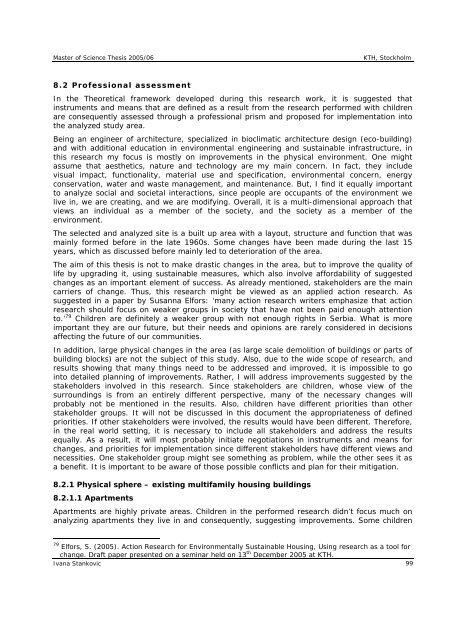Ivana Stankovic
Ivana Stankovic
Ivana Stankovic
You also want an ePaper? Increase the reach of your titles
YUMPU automatically turns print PDFs into web optimized ePapers that Google loves.
Master of Science Thesis 2005/06<br />
KTH, Stockholm<br />
8.2 Professional assessment<br />
In the Theoretical framework developed during this research work, it is suggested that<br />
instruments and means that are defined as a result from the research performed with children<br />
are consequently assessed through a professional prism and proposed for implementation into<br />
the analyzed study area.<br />
Being an engineer of architecture, specialized in bioclimatic architecture design (eco-building)<br />
and with additional education in environmental engineering and sustainable infrastructure, in<br />
this research my focus is mostly on improvements in the physical environment. One might<br />
assume that aesthetics, nature and technology are my main concern. In fact, they include<br />
visual impact, functionality, material use and specification, environmental concern, energy<br />
conservation, water and waste management, and maintenance. But, I find it equally important<br />
to analyze social and societal interactions, since people are occupants of the environment we<br />
live in, we are creating, and we are modifying. Overall, it is a multi-dimensional approach that<br />
views an individual as a member of the society, and the society as a member of the<br />
environment.<br />
The selected and analyzed site is a built up area with a layout, structure and function that was<br />
mainly formed before in the late 1960s. Some changes have been made during the last 15<br />
years, which as discussed before mainly led to deterioration of the area.<br />
The aim of this thesis is not to make drastic changes in the area, but to improve the quality of<br />
life by upgrading it, using sustainable measures, which also involve affordability of suggested<br />
changes as an important element of success. As already mentioned, stakeholders are the main<br />
carriers of change. Thus, this research might be viewed as an applied action research. As<br />
suggested in a paper by Susanna Elfors: ‘many action research writers emphasize that action<br />
research should focus on weaker groups in society that have not been paid enough attention<br />
to.’ 79 Children are definitely a weaker group with not enough rights in Serbia. What is more<br />
important they are our future, but their needs and opinions are rarely considered in decisions<br />
affecting the future of our communities.<br />
In addition, large physical changes in the area (as large scale demolition of buildings or parts of<br />
building blocks) are not the subject of this study. Also, due to the wide scope of research, and<br />
results showing that many things need to be addressed and improved, it is impossible to go<br />
into detailed planning of improvements. Rather, I will address improvements suggested by the<br />
stakeholders involved in this research. Since stakeholders are children, whose view of the<br />
surroundings is from an entirely different perspective, many of the necessary changes will<br />
probably not be mentioned in the results. Also, children have different priorities than other<br />
stakeholder groups. It will not be discussed in this document the appropriateness of defined<br />
priorities. If other stakeholders were involved, the results would have been different. Therefore,<br />
in the real world setting, it is necessary to include all stakeholders and address the results<br />
equally. As a result, it will most probably initiate negotiations in instruments and means for<br />
changes, and priorities for implementation since different stakeholders have different views and<br />
necessities. One stakeholder group might see something as problem, while the other sees it as<br />
a benefit. It is important to be aware of those possible conflicts and plan for their mitigation.<br />
8.2.1 Physical sphere – existing multifamily housing buildings<br />
8.2.1.1 Apartments<br />
Apartments are highly private areas. Children in the performed research didn’t focus much on<br />
analyzing apartments they live in and consequently, suggesting improvements. Some children<br />
79 Elfors, S. (2005). Action Research for Environmentally Sustainable Housing, Using research as a tool for<br />
change. Draft paper presented on a seminar held on 13 th December 2005 at KTH.<br />
<strong>Ivana</strong> <strong>Stankovic</strong> 99
















